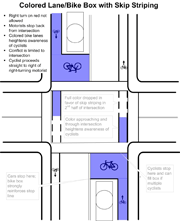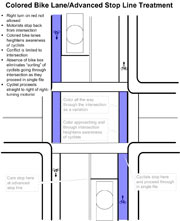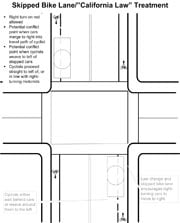
(Photo: Jonathan Maus)
[We’ve heard from the local media, we’ve heard from the Police Bureau, we’ve heard from the BTA, and we’ve heard from the community (through hundreds of comments on various websites and blogs). Now, in this guest article, PDOT bike coordinator Roger Geller shares an in-depth analysis of how the City of Portland Office of Transportation plans to improve bike safety through re-engineering and enhancing dangerous intersections.
Please note, all hyperlinks, callout quotes and some paragraph formatting are the work of the editor (me), not Mr. Geller.]
“PDOT has strongly endorsed the design that enhances separation… similar designs are employed in the world-class cycling cities… whose ridership levels, policies and practices we hope to emulate.”
In the light of two recent “right-hook” crashes resulting in fatalities, Commissioner Sam Adams and PDOT have recommended a pilot treatment at 14 targeted intersections to create safer conditions for bicycling. People following this issue — motorists and cyclists alike — legitimately have questions about the effectiveness of the proposed design and how we selected the 14 intersections.
Following these crashes, there arose two leading and opposing options for treating intersections. One of these options eliminates the separation of cyclists and motorists as they approach intersections; the other maintains and enhances the separation. PDOT has strongly endorsed the design that enhances separation. Our approach is based on two guiding principles:
- To increase bicycle ridership in Portland we need to create comfortable conditions for people to ride. The more people who ride, the better will be conditions for cycling,
- Bicycling is safer when awareness and visibility of road users is enhanced and movements are well defined and universally understood.
We are further encouraged in our decision by the fact that similar designs are employed in the world-class cycling cities throughout Europe whose ridership levels, policies and practices we hope to emulate.
The design we propose consists of three main elements: a bicycle lane that is colored as it approaches the intersection, a bicycle box at the intersection, and a colored bicycle lane leading away through the intersection (see Figures 1 and 2).
Other elements will include signing that alerts motorists to the presence of the bicycle lane and expected motor vehicle and bicycle movements through the intersection, a prohibition against turning right on a red signal, and, where feasible or considered necessary, flashing warning signing triggered by the presence of a cyclist approaching the intersection.
The primary intent of this design is to increase the visibility of cyclists at the intersections.
We wish to heighten motorist’s awareness to the presence, or potential presence of cyclists. We want to remind motorists to look for cyclists who may be crossing their paths as they proceed through the intersection. The blue lanes approaching and leading away from the intersections are intended to be the primary trigger for this awareness. By coloring blue the approach, and especially the trailing lanes through the intersection, we will send motorists a clear message to expect cyclists moving through the intersection.
This practice of using color to define a cyclist’s path through an intersection is a common design feature in the bicycle-friendly cities of Denmark, The Netherlands, and Germany. It is also common in those countries to keep cyclists to the right of the roadway — in their own designated space-and to the right of right-turning motorists. Why? Because, those countries have determined, through the repeated feedback from their citizens and following decades of experimenting and refining their designs, policies, and approaches to managing traffic, that people riding bicycles want to stay separated from motor vehicles.
- [Editor note: Learn more about PDOT’s blue bike lanes, and view a study of their effectiveness here.]
It is this separation that creates comfortable conditions for bicycling. It is this feeling of comfort that serves to encourage more people to bicycle. Creating more cyclists, and having fewer people driving cars, makes bicycling safer.
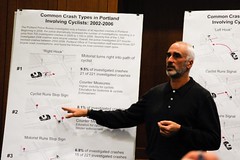
stakeholders meeting last week.
(Photo © Jonathan Maus)
Of course, separation without safety doesn’t serve anybody well. In this case, safer conditions will be achieved, in part, by clearly and unavoidably making known the presence of cyclists at the approach to and through the intersection. We believe the colored bicycle lanes in Portland, as in Copenhagen, Amsterdam, Muenster, and in bicycle-friendly cities throughout Europe, will encourage motorists to stay out of the bicycle lane when approaching an intersection, and look for cyclists before executing their turn through an intersection.
The bicycle box is a separate but related part of the design and is intended to do two things:
- It will allow cyclists to go to the head of the line when the light is red so that they are more visible to queuing motorists and allowed to proceed through the intersection ahead of them,
- It will allow the entire queue of cyclists to come up to the head of the line, so that when the signal turns green there are none or few cyclists moving through the bicycle lane to the right of motorists.
Additional signing and flashing lights would reinforce to motorists the idea to expect cyclists. We feel comfortable testing these designs in Portland because of their successful use in Europe.
However, there is another approach that encourages mixing motor vehicle and bicycle traffic when approaching and going through the intersection. This second approach encourages cyclists and motorists to share either the travel lane by dropping the bicycle lane before the intersection, or to share the bicycle lane, by allowing motor vehicles into the bicycle lane in advance of their making a right turn (Figures 3 and 4).
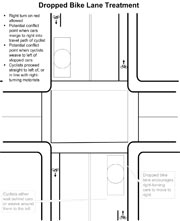
(Click to enlarge)
This is an approach based on a “vehicular cycling” model, which suggests that bicycles, as vehicles operating on the roadway, should behave the same as the primary vehicles for which the roadways were designed: automobiles. The benefit of this approach is that it takes cyclists who are going straight through an intersection away from the path of a right-turning motorist. It conforms to standard automobile operating rules, in which a vehicle going straight is always to the left of a vehicle turning right.
We believe there are a few problems with this approach.
The main problem is that vehicular cycling is generally best used by those cyclists who are already the most fit and confident. While knowledge of vehicular cycling and the skills it encourages are beneficial to all cyclists, requiring such behavior at each intersection would not feel comfortable to the vast majority of Portlanders — the very people we are working to attract to bicycling.
Keep in mind that Dutch cyclists (and motorists) are perhaps the best trained in the world. They are taught throughout elementary school how to ride a bicycle. They generally begin riding a bicycle very young and continue to ride well into old age. Despite this intensity of training, the Dutch have firmly decided that maintaining separation between cyclists and motorists is what creates the most comfortable conditions for bicycling.
The other main problem with this approach is that cyclists and motorists will still cross paths at some point. Either motorists will merge into the bicycle lane (under the California law approach) or cyclists will have to weave across the path of cars (under the dropped bicycle lane approach). In either case, there will still be multiple conflict points. Instead of having one conflict point at the intersection, it is now moved some indeterminate and varied distance back from the intersection. Cyclists can still be in a motorist’s blind spot when the motorist merges to the right.
We believe that inviting motorists into bicycle lanes creates three conditions that will be uncomfortable to most cyclists.
First is the merge itself. It is not clear where this merge will occur and it still allows cyclists to be in a motorist’s blind spot when the motorist moves to the right.
Second is the blocking of the bicycle lane. One of the advantages of having a bicycle lane-the uninterrupted flow for the bicycle-would be eliminated at almost every intersection where there is a line of motorists waiting to turn right.
“We believe that inviting motorists into bicycle lanes creates… conditions that will be uncomfortable to most cyclists.”
Third is the weaving behavior this will encourage of cyclists, who will understandably not be content to stop in a bicycle lane, near the intersection, when the signal is green, and who will instead move left into the travel lane around the right-turning automobiles.
There are places in Portland where we have dropped bicycle lanes before an intersection. We hear many complaints from cyclists where that occurs. We don’t do it to create safe conditions for cyclists. Instead, we drop bicycle lanes in order to better serve motorists at the intersection. Typically dropping the bicycle lane in order to add an additional turn lane.
If Portland is to be successful in attracting the general public to bicycling as a main means of transportation, then we need to create conditions where cyclists both feel comfortable and are safe when operating their bicycles. Dropping bicycle lanes shy of an intersection and encouraging or requiring cyclists to merge left into the travel lane, is not the ticket.
We developed the list of 14 targeted intersections from three primary sources:
- Comments received from the cycling public at the June 2006 Portland Bike Summit
- Feedback from Portland’s Bicycle Advisory Committee regarding deficiencies in the city’s bikeway system
- Feedback from the general public and analysis performed by technical staff as part of the city’s work to define existing conditions for bicycling in Portland as part of the city’s process to update the bicycle master plan.
We have chosen a design approach that we believe will create comfortable conditions for cyclists, improve safety by clarifying what we expect of motorists and cyclists, and continue to encourage increased bicycle use among more of the general public.
We recognize that intersection design alone does not create safe conditions. Appropriate user behavior is crucial to an individual’s safety. Being aware, looking out for others, yielding to others, and operating at slower speeds all help promote safety for all. This is true no less for cyclists than it is for motorists.
Roger Geller
Bicycle Coordinator, City of Portland Office of Transportation
(503) 823-7671
Mr. Geller looks forward to reading and responding to your comments…
